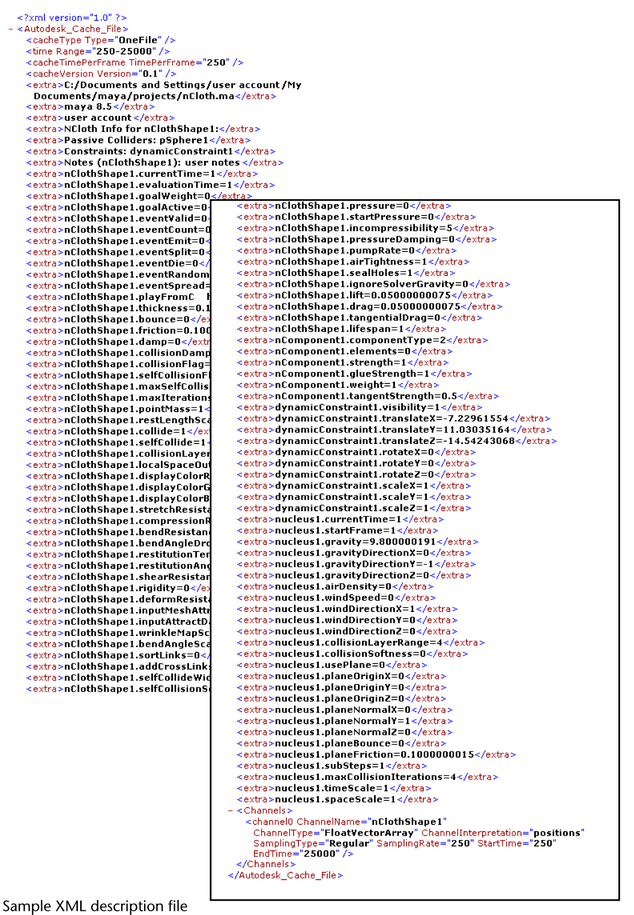When you create an nCache, your cache is saved to disk as a .mc (Maya cache) file and an .xml description file is generated for your cache. The XML (eXtensible Markup Language) description file contains a list of important cache attributes that Maya uses to locate the cache files for your Nucleus objects, and a list of attribute values (see extra) that identifies what object setups correspond with which cache files.
You can use the XML description file to keep track of your nCache files and their associated objects, passive objects, constraints, and scenes.

The nCache information contained in the XML description file is structured or organized by XML element and attribute. Each regular element (such as cacheType and Channel) or nested element (such as channel#) contains single or multiple attributes (such as Type, ChannelName, or SamplingRate) that list specific nCache or object properties.
Specifies the frame or time range of the nCache. For example, if a nCache contains an nCloth object’s simulation from frames 1-25, then the Range attribute would be 250-6250.
The time range is measured in time steps. Time steps are sub-frame units. Each nCache frame contains multiple time steps. The number of time steps contained in a frame is determined by your current Working Units (Time) user preference setting.
Number of time steps per frame = 6000/frame rate. For example, if your Working Units (Time) preference is set to Film (24 fps), then each of your nCache’s frames contains 250 time steps.
Specifies the following for the nCache:
Contains all object or channel-specific cache information.
Each cached object is assigned its own channel# nested element. For example, if you select 5 nCloth objects, set File Distribution to One File or One File Per Frame, and cache their simulations, then one XML description file would be generated and it would contain the following nested elements: channel0, channel1, channel2, channel3, and channel4. However, if you set File Distribution to One File Per Geometry, then one XML description file would be generated for each of the selected objects and only one channel# nested element would appear in each .xml file.
Specifies which type of object data is driven by the channel’s cache. The type of data depends on the type of object that is nCached. For nCloth caches, only the Positions attribute value is supported. Fluid nCaches support the following attribute values: Density, Velocity, Temperature, Fuel, Color, Texture coordinates, and Falloff.
See Caching for information about cachable nParticle attributes.
Specifies whether or not the channel’s simulation samples are saved to disk at equally spaced intervals. Regular indicates that the samples were saved at equally spaced intervals and Irregular indicates that the samples were saved at unequally spaced intervals.
These values are used by Maya to help it search for the channel’s cache files on disk more efficiently.
Typically, the sampling type for an nCache is always Regular after creation. However, if you edit your cache in a way that changes its sampling interval, its sampling type will change to Irregular. For example, if your nCache evaluates every frame, and you append a cache to it that evaluates every 2 frames, then your cache’s sampling type would change to Irregular.
Specifies the spacing of the channel’s nCache files on disk when they were first created.
SamplingRate = Evaluate every # frame(s) x Save every # evaluation (s). For example, if you set Evaluate every # frame(s) to 0.5 and Save every # evaluation(s) to 1, and your user Working Units are set to 24 fps, then one sample would be taken and saved to your nCache every 125 time steps or half-frame.